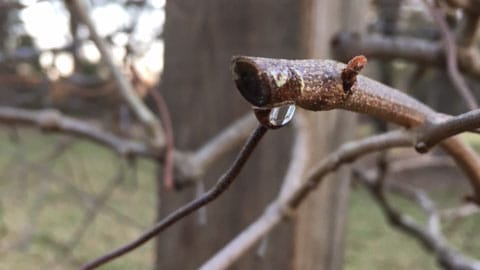Following a late winter or early spring pruning of Maple, Birch, Elm, or Grapevines it is common to observe “bleeding” from the pruning wounds. This phenomenon usually occurs just before and during leaf emergence in the spring, especially during years of abundant soil moisture. The temporary bleeding is generally not detrimental to the health of the plant and primarily consists of a watery sap solution. The bleeding usually ceases once the leaves have fully emerged and water begins to evaporate through the leaf stomata, creating transpirational pull that overshadows the root pressure.
The upward flow of water is caused by osmotic pressure in the root system that begins with the imbalance of water molecules between the soil and the root system. A high concentration of minerals and carbohydrates in the root system generally translates to a lower concentration of water molecules when compared to the surrounding soil. Water molecules enter the root cells to equalize distribution, causing root cells to become turgid and force water upwards in the vascular system. (Incidentally, the reverse is true when too much fertilizer is applied and a higher concentration of minerals in the soil prevents the osmotic absorption of water into the root system.)
Occasionally, bleeding can be a nuisance where these plants drip on parked cars and pedestrian spaces. In such cases, delay pruning of these species until late spring-early summer to help to reduce the issue.
If prolonged bleeding occurs and you observe any unusual signs or symptoms of pests or disease, report the information to your local extension agent for further assessment.
- Landscape Alerts & Updates | September 2019 - September 20, 2019
- Landscape Alerts & Updates | June 2019 - June 20, 2019
- Landscape Alerts and Updates | April 2019 - April 20, 2019
